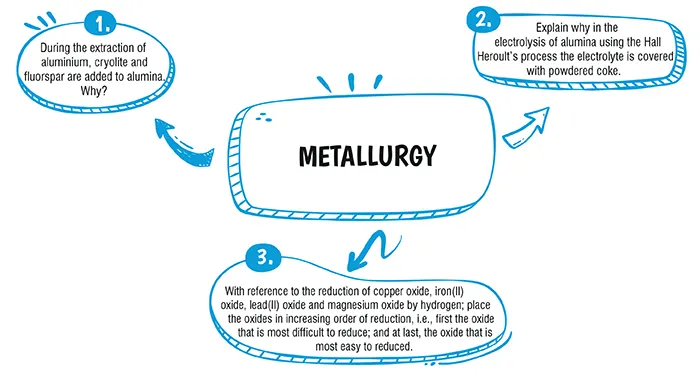Table of Contents

Ans. (C) Bronze
Explanation:
Bronze is an alloy composed primarily of copper, along with varying proportions of tin. It's one of the earliest alloys developed by humans and has been used for thousands of years due to its desirable properties, such as durability, malleability, and resistance to corrosion. The addition of tin to copper in bronze improves the hardness and strength of the metal, making it suitable for various applications, including tools, weapons, sculptures, and decorative objects. While zinc is not a primary component of bronze, it can sometimes be present in small amounts as an impurity or as an intentional addition for specific purposes.
Ans. (a) Adsorption
Explanation:
Froth flotation process for the concentration of sulphide ores illustrates the application of adsorption because in this process ores are adsorbed on the surface of the froth collector.
Explanation:
Cryolite and fluorspar are added to alumina :
(i) To lower the melting point of aluminium.
(ii) To make alumina a good conductor of electricity.
(iii) Cryolite acts as a solvent for alumina.
Explanation:
The Hall-Heroult process is the electrolytic process of alumina to obtain molten aluminium. In the Hall-Heroult process, powdered coke is used to reduce heat loss by radiation and prevent the burning of anode. In the Hall-Heroult process, pure alumina is mixed with cryolite. This results in a lowering of the melting point of the mixture, so its ability to conduct electricity increases. A steel vessel with a lining of carbon and graphite is used in the process.The carbon lining acts as cathode and carbon lining acts as anode. After passing electricity through the electrolyte consisting of a carbon electrode, oxygen is formed at anode. This leads to the formation of carbon monoxide and carbon dioxide by reacting the formed oxygen with the carbon anode. In this process, for every 2 units of aluminium formed 1 unit of carbon anode is burned. To prevent this burning of anode we use powdered coke as a covering for the electrolyte.
Explanation:
(a) Magnesium oxide, Iron (II) oxide, Lead (II) oxide, and then copper (II) oxide
(b) (1) Ionic bonding (or electrovalent bonding) is expected in metallic chlorides. Metals transfer their excess electrons to nonmetals that are electron deficient. Thus, both attain stability and form an ionic or electrovalent bond. Example: in sodium chloride, sodium donates its one extra electron to chlorine. Therefore, sodium loses one electron and chlorine gains one electron, attaining stability in the process and forming an ionic bond.
(2) Fused metal chloride contains free ions: metal cations and chloride anions. If fused metal chloride is electrolyzed, the positively charged metal ions (cations) are attracted toward the cathode (negatively charged electrode). These metal ions obtain electrons from the cathode and get reduced to metal atoms. Example: During the electrolysis of fused sodium chloride, sodium ions are attracted to the cathode.
(3) Even though graphite (an allotrope of carbon) is a non-metal, it is a good conductor of electricity. Thus, graphite conducts electricity and resembles metal in terms of its electrical conductance.
Download Mind Map of this chapter
Download NowWant to Practice Mock Tests of this chapter
Practice NowDownload Important Questions of this chapter
Download Now| Chapter No. | Chapter Name |
|---|---|
| Chapter 1 | Periodic Properties and Variations of Properties |
| Chapter 2 | Chemical Bonding |
| Chapter 3 | Study of Acids, Bases and Salts |
| Chapter 4 | Analytical Chemistry |
| Chapter 5 | Mole concept and Stoichiometry |
| Chapter 6 | Electrolysis |
| Chapter 7 | Metallurgy |
| Chapter 8 | Study of Compounds : Hydrogen Chloride |
| Chapter 9 | Study of Compounds : Ammonia and Nitric Acid |
| Chapter 10 | Study of Compounds : Sulphuric Acid |
| Chapter 11 | Organic Compounds |
| Chapter Wise Important Questions for ICSE Board Class 10 Chemistry |
|---|
| Periodic Properties and Variations of Properties |
| Chemical Bonding |
| Study of Acids, Bases and Salts |
| Analytical Chemistry |
| Mole concept and Stoichiometry |
| Electrolysis |
| Metallurgy |
| Study of Compounds : Hydrogen Chloride |
| Study of Compounds : Ammonia and Nitric Acid |
| Study of Compounds : Sulphuric Acid |
| Organic Compounds |
CBSE Important Questions Class 10
ICSE Important Questions Class 10
CBSE Important Questions Class 10
ICSE Important Questions Class 10